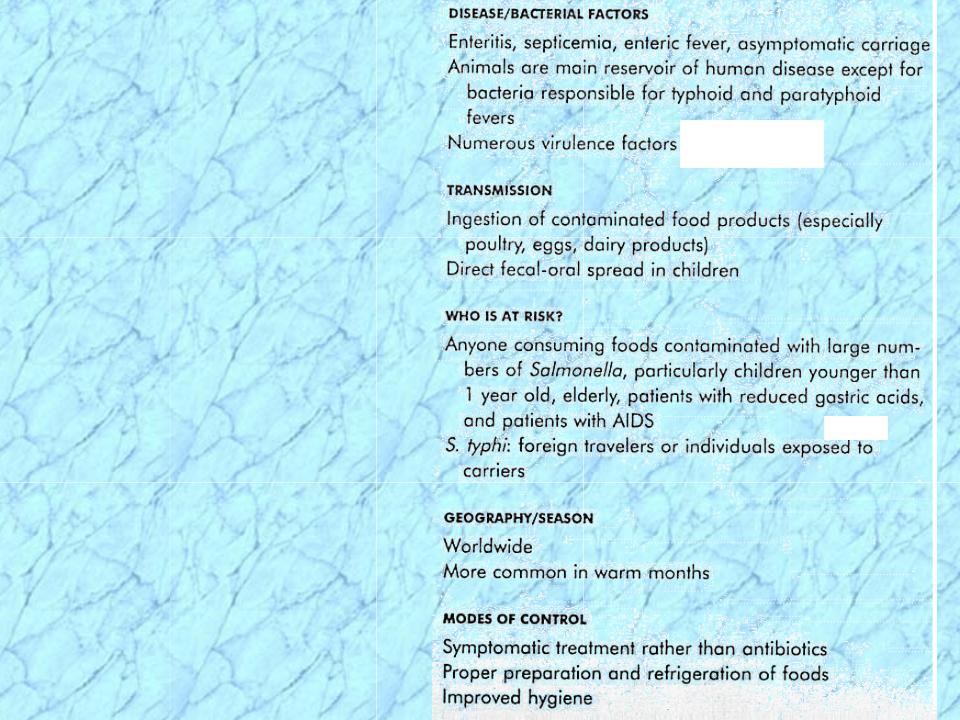
- •True Pathogens
- •Anatomy of Digestive Tract
- •Anatomy of Digestive Tract (cont.)
- •General Characteristics of Salmonella
- •Classification and Taxonomy of
- •Epidemiology
- •Annual Reported Incidence
- •Clinical Syndromes of Salmonella
- •Epidemiology and Clinical Syndromes
- •Pathogenesis of Salmonella
- •Pathogenesis of Salmonella (cont.)
- •Clinical
- •Epidemiology & Clinical Syndromes (cont.)
- •Pathogenesis of Salmonella (cont.)
- •Microbial Defenses Against Host
- •Methods That Circumvent
- •Epidemiology & Clinical Syndromes (cont.)
- •Epidemiology & Clinical Syndromes (cont.)
- •Treatment, Prevention and Control of
- •General Characteristics of Shigella
- •Epidemiology and Clinical Syndromes
- •DEFINITIONS
- •Epidemiology
- •Pathogenesis of Shigella
- •Pathogenesis and Virulence Factors (cont.)
- •Pathogenesis and Virulence Factors (cont.)
- •Pathogenesis and Virulence Factors (cont.)
- •Methods That Circumvent
- •Pathogenesis and Virulence Factors (cont.)
- •Pathogenesis and Virulence Factors (cont.)
- •Pathogenesis and Virulence Factors (cont.)
- •Heparin-binding epidermal growth factor on heart & nerve surfaces
- •Summary of Yersinia Infections
- •Epidemiology and History of Plague
- •Epidemiology
- •Epidemiological Cycles of Plague
- •Epidemiological
- •Annual
- •Annual
- •Arthropod-Borne Transmission of Plague
- •Yersinia
- •Yersinia
- •REVIEW
- •See Handouts
- •Salmonella
- •Salmonella
- •Clinical Syndromes of Salmonella
- •Epidemiology and Clinical Syndromes
- •Pathogenesis of Salmonella
- •Clinical
- •Shigella
- •Shigella
- •Epidemiology and Clinical Syndromes
- •DEFINITIONS
- •Pathogenesis of Shigella
- •Pathogenesis and Virulence Factors (cont.)
- •Pathogenesis and Virulence Factors (cont.)
- •Yersinia
- •Yersinia
- •Summary of Yersinia Infections
- •Epidemiology and History of Plague
- •Epidemiological Cycles of Plague
- •Epidemiological


True Pathogens
of the
Enterobacteriaceae:
~~~~~~~~~~~~~~~~~~~~~~~~~~~~~~~~~~~~~
Salmonella,
Shigella & Yersinia

Anatomy of Digestive Tract
Digestive tract is a “tube” (from mouth to anus); technically “outside” of the body
Lumen = space within tubular or hollow organ such as an artery, vein, or intestine
Intestinal lumen = the inside of the intestine
Mesentery = membrane attaching organ (e.g., intestine) to body wall; often has lymphoid tissue
Food is moved down tract via peristalsis
Entire length of digestive tract epithelium is covered by mucosal membrane (mucosa) with mucus that is secreted from specialized glands
Surface area of intestine increased by presence of villi (finger-like projections) and microvilli that absorb nutrients and other products of digestion

Anatomy of Digestive Tract (cont.)
Mouth, pharynx, esophagus & esophageal sphincter
Stomach and pyloric valve (sphincter)
Small intestine (about 23 feet in length)
Duodenum (~10” in length) (bile & pancreatic ducts carry digestive juices secreted by gall bladder, liver & pancreas)
Jejunum (~8 feet in length)
Ileum (final 3/5 of length) and ileocecal valve
Absorbs bile salts & nutrients, including vitamin B12
Large intestine
Cecum(caecum) (blind pouch where appendix also enters)
Colon (ascending, transverse, descending, sigmoid)
Rectum and anus (with internal and external sphincters)

General Characteristics of Salmonella
Coliform bacilli (enteric rods)
Motile gram-negative facultative anaerobes
Non-lactose fermenting
Resistant to bile salts
H2S producing

Classification and Taxonomy of
Salmonella (Confused)
Old: Serotyping & biochemical assays used to name individual species within genus
(e.g., Salmonella enteritidis, S. choleraesuis, S. typhi)
|
Over 2400 O-serotypes (referred to as species) |
|
(Kauffman-White antigenic schema) |
|
Bioserotyping (e.g., S. typhimurium) |
New: DNA homology shows only two species
Salmonella enterica (six subspecies) and S. bongori
Most pathogens in S. enterica ssp. enterica

Epidemiology
of Salmonella
Infection

Annual Reported Incidence |
|
Salmonella Infection |
(exclud |
typhoid fever) |
|

Clinical Syndromes of Salmonella
Salmonellosis = Generic term for disease
Clinical Syndromes
Enteritis (acute gastroenteritis)
Enteric fever (prototype is typhoid fever and less severe paratyphoid fever)
Septicemia (particularly S. choleraesuis, S. typhi,
and S. paratyphi)
Asymptomatic carriage (gall bladder is the reservoir for Salmonella typhi)

Epidemiology and Clinical Syndromes
of Salmonella (cont.)
Enteritis
Most common form of salmonellosis with major foodborne outbreaks and sporadic disease
High infectious dose (108 CFU)
Poultry, eggs, etc. are sources of infection
6-48h incubation period
Nausea, vomiting, nonbloody diarrhea, fever, cramps, myalgia and headache common
S. enteritidis bioserotypes (e.g., S. typhimurium)

Pathogenesis of Salmonella
Enteritis (cont.)
Virulence attributable to:
Invasiveness
Intracellular survival & multiplication
Endotoxin
Exotoxins: Effects in host have not been identified
Several Salmonella serotypes produce enterotoxins similar to both the heat-labile (LT) and heat-stable enterotoxins (ST), but their effect has not been identified
A distinct cytotoxin is also produced and may be involved in invasion and cell destruction
